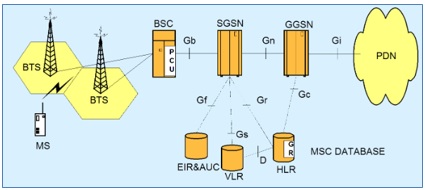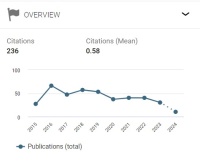A Literatur Review Green Energy Pada Pemancar Sistem Komunikasi Seluler
Abstract
The number of users and the frequency of use of telecommunications systems are increasing rapidly and causing a greater demand for energy use. Based on many studies conducted by various network operators, that the largest energy consumption and the most impact on the environment is wireless networks from both the recipient and sender sides. The amount of CO2 emissions is increasing in communication systems, equivalent to the increase in cellular consumers. And it is also observed that the current wireless network is not energy efficient, especially the Base Station (BTS).
The rapid and alarming growth in wireless network users is forcing us to use higher mobile broadband data rates. The need for an urgent network architecture restructuring in order to provide good service but still be environmentally friendly. In this article, we will discuss several innovative methods to increase the energy efficiency of wireless networks and develop solutions that reduce operating costs and the impact on the environment.
Downloads
References
[2] Dhillon, H. S., Singh, G., & Gupta, S. (2020). Green communications for future wireless networks: A review. Renewable and Sustainable Energy Reviews, 120, 109640.
[3] Ko, Y. C., & Chang, Y. C. (2020). A survey of green communication in 5G networks. Sustainability, 12(13), 5433.
[4] Saravanan, R., & Shunmuga Sundari, R. (2020). A Review of the Evolution of Mobile Wireless Networks from 1G to 5G. Journal of Advanced Research in Dynamical and Control Systems, 12(2), 1982-1989.
[5] Zhang, X., Zhang, S., & Wang, X. (2021). A Survey on the Evolution of Cellular Network Technologies. IEEE Network, 35(2), 18-25.
[6] Li, Q., Liu, Y., & Li, M. (2020). From 1G to 5G: A Comprehensive Review of Cellular Network Technology. IEEE Wireless Communications, 27(4), 16-23.
[7] Jiang, H., Ding, L., & Li, G. Y. (2020). A Review of the Evolution of Mobile Communication Technologies. IEEE Access, 8, 164290-164301.
[8] Wang, J., Liu, Y., Li, Q., Cui, J., & Li, M. (2021). 6G Wireless Networks: Vision, Requirements, Architecture, and Key Technologies. IEEE Network, 35(3), 444-451.
[9] Zeb, K., Shami, A., & Malik, A. W. (2020). A review of green communication in 5G and beyond: Recent trends and open research challenges. Computer Networks, 178, 107200.
[10] Global e-Sustainability Initiative (GeSI). (2021). Enabling the low carbon economy in the information age. https://www.gesi.org/reports/enabling-the-low-carbon-economy-in-the-information-age
[11] Greenpeace. (2019). Clicking Clean Virginia: The Dirty Energy Powering Data Center Alley. https://www.greenpeace.org/usa/reports/clicking-clean-virginia/
[12] United States Environmental Protection Agency (EPA). (2012). Report to Congress on Server and Data Center Energy Efficiency: Public Law 109-431. https://www.energystar.gov/sites/default/files/buildings/tools/Servers_Data_Center_Report_Congress_Final1.pdf
[13] European Union (EU). (2013). Code of Conduct on Energy Efficiency of Digital TV Service Systems. https://publications.europa.eu/en/publication-detail/-/publication/6c7a6f70-06fc-4f07-80b2-9e0b94f4e53d/language-en
[14] Natural Resources Defense Council (NRDC). (2019). The Growing Carbon Footprint of Streaming Video. https://www.nrdc.org/sites/default/files/growing-carbon-footprint-streaming-video-IP.pdf
[15] Nguyen, D. K., Nguyen, T. N., Nguyen, V. H., & Nguyen, T. H. (2020). Energy-efficient communications for future wireless networks: A review. IEEE Access, 8, 14474-14493.
[16] Ericsson. (2021). Energy and carbon impact of 5G mobile networks. https://www.ericsson.com/en/reports-and-papers/reports/5g-energy-and-carbon
[17] Global e-Sustainability Initiative (GeSI). (2021). Enabling the low carbon economy in the information age. https://www.gesi.org/reports/enabling-the-low-carbon-economy-in-the-information-age
[18] R. K. Singh, A. Patel, and P. Singh, "A Review of Green Energy and its Applications in Mobile Communication Networks," in 2020 3rd International Conference on Computing, Communication, and Security (ICCCS), 2020, pp. 1-5. doi: 10.1109/ICCCS48896.2020.9093237.
[19] B. Ghatol, A. Ghatol, and N. H. Mulla, "A Review of Green Energy Techniques in Cellular Networks," in 2020 International Conference on Smart Electronics and Communication (ICOSEC), 2020, pp. 1-5. doi: 10.1109/ICOSEC49003.2020.9283312.
[20] Chen, H., & Xu, Z. (2015). Research on the Application of Mobile Communication Technology in Smart Grid. 2015 International Conference on Intelligent Transportation, Energy, and Grid (iTEG). IEEE.
[21] Li, Y., Zhang, W., & Zhang, Y. (2014). Communication technology in the smart grid: Existing and emerging technologies. IEEE Communications Surveys & Tutorials, 16(1), 525-540.
[22] Liang, X., Zhang, H., & Xu, Y. (2017). Integration of smart grid and 5G mobile networks: A survey. IEEE Access, 5, 17320-17336.
[23] Lu, R., Li, H., & Liang, X. (2018). Smart grid and 5G wireless communication: Opportunities and challenges. IEEE Wireless Communications, 25(2), 24-31.
[24] Yilmaz, H. B., & Akkaya, K. (2017). A survey on smart grid communication infrastructures: Motivations, requirements and challenges. Ad Hoc Networks, 57, 112-131.
[25] Zhang, Y., Zhou, K., Zhang, Y., & Zhang, H. (2015). Smart grid communication networks: An overview on communications, architecture, and optimization. IEEE Communications Surveys & Tutorials, 17(1), 425-445.
[26] Global e-Sustainability Initiative (GeSI). (2019). The impact of the telecommunications ecosystem on climate change.
[27] Ericsson. (2018). 5G energy efficiency – powering a sustainable future.
[28] World Wildlife Fund (WWF). (2020). Renewable Energy for Telecom Towers: A Roadmap for Implementation in Emerging Markets.
[29] Greenpeace. (2019). Greenpeace Report: Clicking Clean Virginia – The Dirty Energy Powering Data Center Alley.
[30] Kementerian Komunikasi dan Informatika Indonesia. (2018). Keputusan Menteri Komunikasi dan Informatika Republik Indonesia Nomor 187 Tahun 2018 tentang Pedoman Teknis Penyelenggaraan Jaringan Telekomunikasi Ramah Lingkungan (Green Telco).
[31] Elshaer, H. M., & Moharram, M. A. (2021). Green communication in wireless networks: Survey, challenges, and future directions. Computer Networks, 193, 108100.
[32] Zeb, K., Shami, A., & Malik, A. W. (2020). A review of green communication in 5G and beyond: Recent trends and open research challenges. Computer Networks, 178, 107200.
[33] T. Khaleel, F. Hussain, and S. A. Hussain, "A Review of Green Energy Sources, Algorithms and Approaches for Telecommunication Network," in 2021 International Conference on Advances in Computing, Communication, Control and Networking (ICACCCN), 2021, pp. 1-5. doi: 10.1109/ICACCCN51794.2021.9544524.
[34] M. G. Sharma and M. R. Jain, "Study of Green Energy in Telecommunications," in 2020 International Conference on Communication and Electronics Systems (ICCES), 2020, pp. 588-592. doi: 10.1109/ICCES49234.2020.9123654.
[35] I Gede Made Surya Bumi Pracasitaram, Linawati, Rukmi Sari Hartati. Konsep Dan Penerapan Green Computing Di Lingkungan Kampus, Majalah Ilmiah Teknologi Elektro, Vol. 18, No. 3, September – Desember 2019
[36] Carmine Lubritto. Telecommunication Power System: energy saving, renewable sources and environmental monitoring. Department of Environmental Science, II University of Naples, ITALY 2009
[37] Zahra Nurkarima Budiwati Attori, Udisubakti Ciptomulyono, Satria Fadil Persada Green Information Technology in Indonesia A Systematic Literature Review, IPTEK Journal of Proceedings Series No. (7), 2020.
[38] Tao Yu, Shunqing Zhang A Novel Energy Efficiency Metric for Next Generation Wireless Communication Networks. JOURNAL OF LTE A X CLASS FILES, VOL. 14, NO. 8, AUGUST 2022
[39] Hong-Chuan Yang,. Characterizing Energy Efficiency of Wireless Transmission for Green Internet of Things: AData-Oriented Approach, Department of Electrical and Computer Engineering, University of Victoria,2018


This work is licensed under a Creative Commons Attribution-NonCommercial-NoDerivatives 4.0 International License.

This work is licensed under a Creative Commons Attribution 4.0 International License




